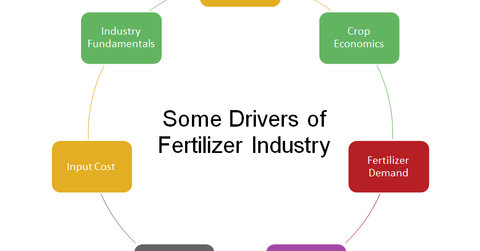Analyzing the key factors that affect the fertilizer industry
The Essential Fertilizers Weekly series comprises key factors that have a potential impact on the bottom line—depending on revenue and expenses.
Nov. 8 2013, Updated 2:30 p.m. ET

The importance of the bottom line
The performance of any investment over the medium to long term largely depends on ongoing or expected changes in the bottom line. This includes metrics like EPS (earnings per share), free cash flow per share, EBITDA (earnings before interest, tax, depreciation, and amortization), and dividends per share. When the bottom line is rising or expected to rise, the market will bid prices up. Conversely, when it’s expected to deteriorate or is declining, share prices tend to fall.
Revenue and expense drive earnings
The Essential Fertilizers Weekly series comprises key factors that have a potential impact on that bottom line—depending on revenue and expenses. Higher revenues and lower expenses are positive, while lower revenues and higher expenses are negative for companies and ETFs like CF Industries Holdings Inc. (CF), Potash Corp. (POT), Mosaic Co. (MOS), Agrium Inc. (AGU), and the VanEck Vectors Agribusiness ETF (MOO).
Fertilizer prices
In the fertilizer industry—and pretty much any other commodity companies—revenue depends on fertilizer prices and the quantity of fertilizer companies sell. Fertilizer prices are driven by industry capacity, rivalry (competition among firms), marginal producers’ cost, proximity to customers, inventory, and demand.
Fertilizer demand and purchases
Demand, in turn, is driven by fertilizer prices, crop economics, currencies, cycles, economic activity, and macro factors like subsidy programs. Crop economics consist of factors like crop inventory, crop demand and supply, and crop prices, which depend on economic activity, food consumption, diet patterns, crop yields, nutrient application, weather, plantation, and energy consumption.
The cost of raw material input
Expenses generally depend on changes in mining costs and fluctuations in raw material prices, which vary by location. Fluctuations in raw material prices or input prices depend on supply and demand dynamics for the specific raw material, which are affected by macro economic activity, weather, and industry-specific trends. Movements in input price can impact fertilizer prices—and therefore demand too.
As you can see, analyzing the factors that affect expense and revenue can be confusing. This weekly fertilizer series breaks them down into key parts to show investors how they’re affecting (or how they could affect) the industry and its respective companies.
This week’s update
Note that the factors mentioned above as a start aren’t comprehensive or as detailed as possible. This week, we’ll cover crop prices, U.S. retail fertilizer prices, Newcastle coal price, wholesale urea prices in China, the relative expensiveness of farm products, and the Indian rupee.
